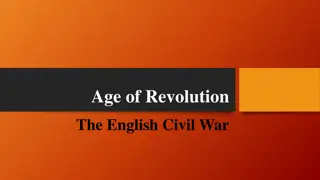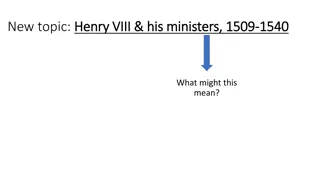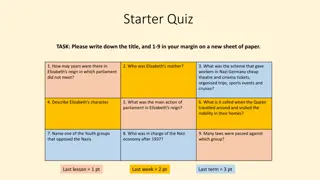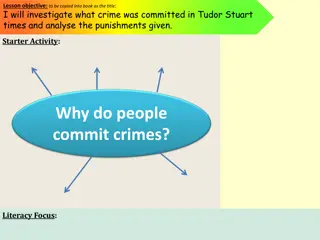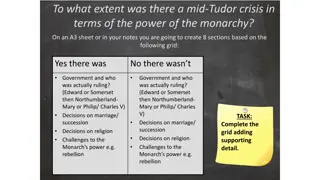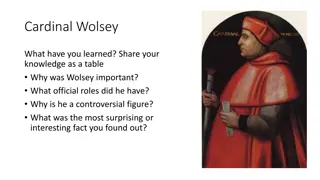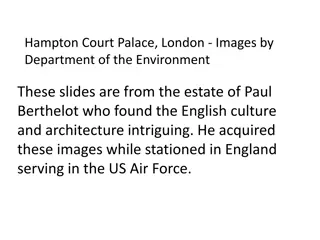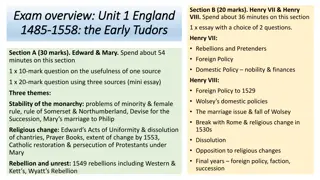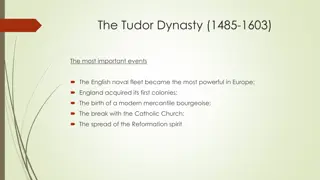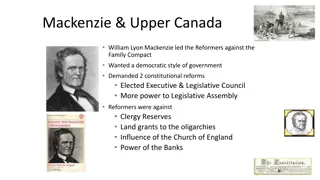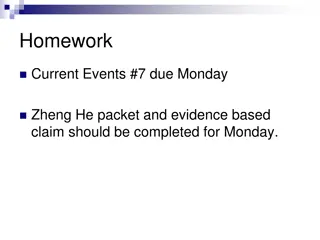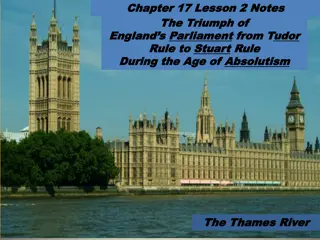
Tudor Rebellions: Causes, Consequences, and Locations
Explore the political, religious, and social factors that led to Tudor rebellions in England, along with their objectives, duration, and locations. Discover the impact of dynastic issues, ambitious advisers, government interventions, and economic hardships, shedding light on the turbulent Tudor era.
Download Presentation

Please find below an Image/Link to download the presentation.
The content on the website is provided AS IS for your information and personal use only. It may not be sold, licensed, or shared on other websites without obtaining consent from the author. If you encounter any issues during the download, it is possible that the publisher has removed the file from their server.
You are allowed to download the files provided on this website for personal or commercial use, subject to the condition that they are used lawfully. All files are the property of their respective owners.
The content on the website is provided AS IS for your information and personal use only. It may not be sold, licensed, or shared on other websites without obtaining consent from the author.
E N D
Presentation Transcript
The Tudors 1509 Henry VIII 1547 Edward VI 1558 Elizabeth 1 1485 Henry VII 1553 Mary I 1603
Political factors as a cause of Tudor Rebellions Evil Advisers Government intervention in England and Ireland Political causes Factions Dynastic issues and succession
Religion as a cause of rebellion in England Year Name of rebellion Catholic or Protestant? Reason Local or regional? Religion main or subsidiary cause? 1536 Pilgrimage of Grace Catholic Reaction to the closure of monasteries and other Protestant reforms Regional in seven northern counties Main 1549 Western Rebellion Catholic Reaction to a new English Prayer Book Local to Devon and Cornwall Main 1549 Kett s Rebellion Protestant Demanded further Protestant reforms Local to Norfolk Subsidiary 1554 Wyatt s rebellion Protestant Fear of Catholic reformation Local to Kent Subsidiary 1569 Northern Earls rebellion Catholic Reaction to Protestant reforms Regional in four northern counties Main
Social and economic causes Rebellions in Rebellions in 1489 1497 1525 1536 1549 1536 1549 1596 Taxation Enclosures Economic and Social Causes Famine and disease Inflation and social issues Rebellion in 1596 Rebellion in 1536 1549
The causes of Tudor rebellions Dynastic issues and the succession Ambitious and Ruthless Advisers Factions Government intervention in England and Ireland Political Causes Religious Economic and social Catholic reaction to Protestant reform Catholic reaction to Protestant reform Taxation Enclosures Famine and disease Inflation and social issues Protestant reaction to slow and indequate Protestant reforms
Objectives, duration and location Objectives Overthrow the government Remedy grievances Increase Irish independence Duration Location Hours Days Weeks Months Years Pro-Yorkists areas South-West England Customary practices Local magnates London, towns and cities
Leadership Royal claimants Nobility and gentry Clergy Leadership Commoners Lawyers
Strategy and tactics Type of rebellion Strategy Tactics Dynastic rebellions Raise an army and overthrow the ruler Gather widespread support prior to fighting a battle Anti-Government protests in England Pressurise the authorities into remedying grievances Popular demonstrations and intimidation of officials and local leaders Irish rebellions Disrupt the Dublin administration Attack English landowners and officials through the use of violence and guerrilla warfare
Organisation Unite disparate groups Maintain discipline Main organisation aims Enlist and pay troops Hold regular musters Keep rebels informed Requisition food and equipment
Size, support and frequency of rebellions Range of support Nobles Foreigners Commoners Mixed Size of rebellion Frequency of Rebellions in England and Ireland 1497: 15,000 Cornish 1485-1509: Six rebellions 1536: 30,000+ Pilgrimage of Grace 1509-1547: Three rebellions 1549: 16,000 Kett 1547-1553: Two rebellions 1554: 3,000 Wyatt 1553-1558: Two rebellions 1569: 6,000 Northern Earls 1558-1603: Seven rebellions 1595: 6,000 O Neil 1601: 300 Essex
Irish Rebellions Key features Scale Duration Irish Rebellions Turning points Direct rule Anglicisation Reformation
Factors determining whether a rebellion was likely to succeed or fail Length of rebellion Governments determination to resist or suppress it quickly Proximity to London Success of failure? Quality of leadership and organisation Degree of noble and gentry support Extent of a rebellion s provincialism Size of popular support Military and financial backing
How did Tudor Governments deal with rebellions? a) Consult advisers b) Gather information c) Send out instructions a) Buy Time Strategy a) Military casualties b) Propaganda Government responses Tactics Fate of the rebels c) Pre-emptive measures b) Trails and retribution d) Raise Troops
The effects of rebellion on government and society Crown servants: under pressure to resign Policy changes: in taxation, uses, enclosures, social and economic reforms, the Council of the North Ireland: serious political and financial cost Effects on Tudor government and society Religious Foreign affairs: the impact on wars and on European relations developments: the crown resisted calls for reforms
Were the Tudors ever seriously threatened by rebellions? Factors that increased a rebellion s seriousness Factors that weakened a rebellion s seriousness Size, support, and backing of English nobles and foreign powers. A rebellion s objective, e.g. To overthrow the monarch Its proximity Governments held their nerve or made deals they had no intention of honouring. Most rebellions were localised protests Most of the English nobility and clergy supported the Crown.
How did Tudor Governments respond to rebellion?
Buy Time Tudor governments had limited resources available to them e.g. no police force and limited money Their main weapon was their claim to be legitimate ruler anointed with holy oil and chosen by God Therefore traitors were also condemned as sinners Governments sought to buy time until they have enough troops to call the rebels bluff and then they would declare battle Battles however were generally avoided. They were expensive and uncertain. Therefore pardons were offered often on the eve of Battle.
Examples Rebels at Stoke (Simnel) and Blackheath (Cornish) were offered pardons on the eve of battle. Pilgrimage of Grace 1536 Henry VIII allowed the Duke of Norfolk to negotiate Western Rebellion The Duke of Somerset sent a series of letters to the rebel camp urging them to desist offering them a free pardon if they did.
Propaganda Propaganda was widely used by governments in trying to persuade rebels to give up and return home. Written Propaganda had limited impact as most could not read. Instead it was designed to reinforce moral of the government Sermons and Speeches
Examples Cromwell employed a team of writers to condemn rebellion in 1536 Henry VIII personally replied to the letters where he defended his policies Cranmer attacked the rebels during 1549 Somerset also sent preachers to appeal at their camp on Mousehold Heath, near Norwich.
Pre-emptive Measures Monarchs sometimes tried to weaken the power of rebels before they became too dangerous
Examples Henry VII used a papal bull to excommunicate rebels on the eve of the Battle of Stoke and Blackheath to encourage many rebels to surrendered rather than risk eternal damnation. Mary sent letters prior to the outbreak of the Wyatt rebellion denouncing the plot. Elizabeth heard some rumours in the summer in 1569 that there are several disgruntled nobles. Elizabeth acted quickly and Norfolk denied permission to marry. Mary was moved 30 miles south to Coventry
Raise Troops The decision to raise troops was not taken lightly. It was expensive and if not paid they were as much a threat as the rebels themselves. Relied on the nobility and gentry to provide retainers Nobility required licences for large scale retaining
Examples Somerset had to carefully deploy his troops as he faced rebellion across the country. Focussed on those near London which is why the Western and Kett s took so long to suppress. This was also why he was the only ruler to employ foreign mercenaries. Henry VII took action against retaining as for him it threatened his throne in those years immediately after WOR.
Trials and Retribution Those rebels who indulged in treason knew that the penalty was death but not all rebels were subsequently executed.
Examples Henry VII- was quiet lenient often using bonds and recognisances. Attainders and Fines Henry VIII Amicable Grant 18 taken for trial and then released and paid compensation. POG 20 clerics executed 60 laymen executed Edward VI 100 hung Devon Kett and ringleaders hung Mary LJG lenient Wyatts 1000 caught 600 pardoned 71/480 executed Elizabeth NE 300 villages burned 450/700 rebels executed. Oxford 5 ringleaders tortured and hung drawn and quartered


